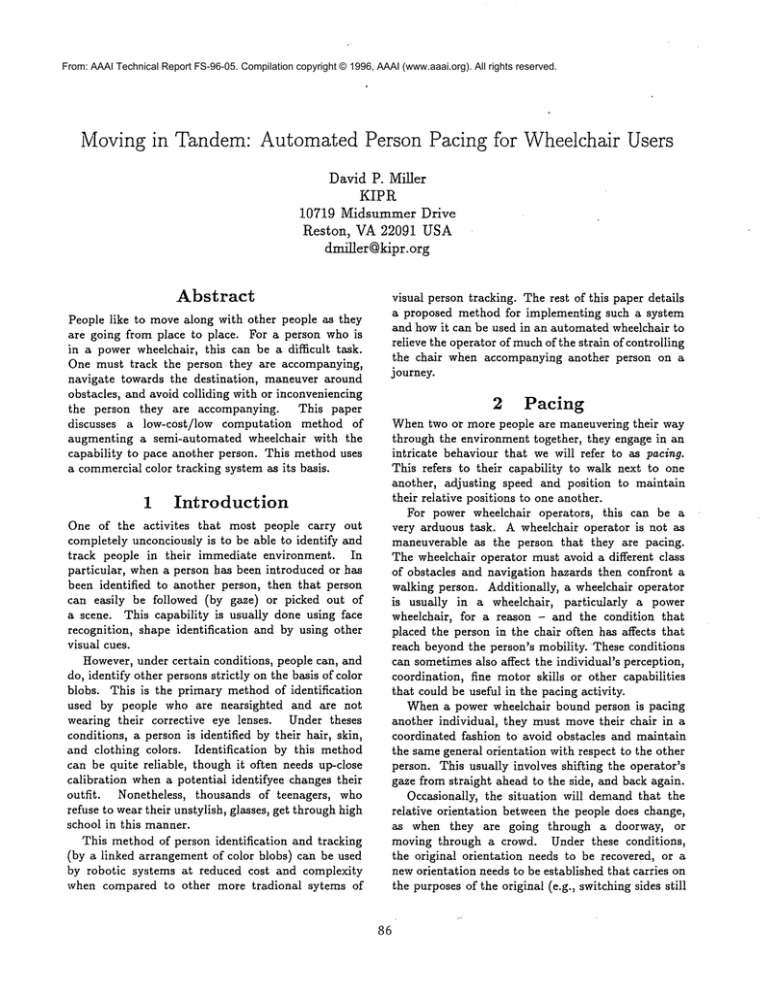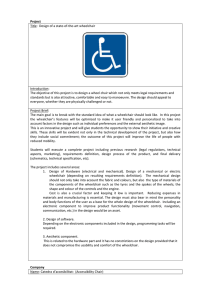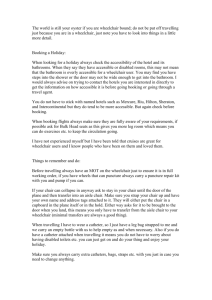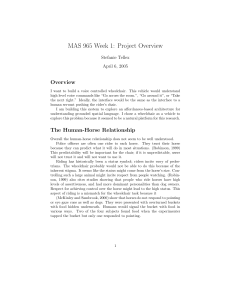
From: AAAI Technical Report FS-96-05. Compilation copyright © 1996, AAAI (www.aaai.org). All rights reserved.
Moving in Tandem: Automated Person Pacing for Wheelchair Users
David P. Miller
KIPR
10719 MidsummerDrive
Reston, VA 22091 USA
dmi|ler@kipr.org
Abstract
visual person tracking. The rest of this paper details
a proposed method for implementing such a system
and how it can be used in an automated wheelchair to
relieve the operator of muchof the strain of controlling
the chair when accompanying another person on a
journey.
People like to move along with other people as they
are going from place to place. For a person who is
in a power wheelchair, this can be a difficult task.
One must track the person they are accompanying,
navigate towards the destination,
maneuver around
obstacles, and avoid colliding with or inconveniencing
the person they are accompanying. This paper
discusses a low-cost/low computation method of
augmenting a semi-automated wheelchair with the
capability to pace another person. This method uses
a commercial color tracking system as its basis.
2 Pacing
Whentwo or more people are maneuvering their way
through the environment together, they engage in an
intricate behaviour that we will refer to as pacing.
This refers to their capability to walk next to one
another, adjusting speed and position to maintain
their relative positions to one another.
For power wheelchair operators, this can be a
very arduous task. A wheelchair operator is not as
maneuverable as the person that they are pacing.
The wheelchair operator must avoid a different class
of obstacles and navigation hazards then confront a
walking person. Additionally, a wheelchair operator
is usually in a wheelchair, particularly
a power
wheelchair, for a reason - and the condition that
placed the person in the chair often has affects that
reach beyond the person’s mobility. These conditions
can sometimesalso affect the individual’s perception,
coordination, fine motor skills or other capabilities
that could be useful in the pacing activity.
When a power wheelchair bound person is pacing
another individual, they must move their chair in a
coordinated fashion to avoid obstacles and maintain
the same general orientation with respect to the other
person. This usually involves shifting the operator’s
gaze from straight ahead to the side, and back again.
Occasionally, the situation will demand that the
relative orientation between the people does change,
as when they are going through a doorway, or
moving through a crowd. Under these conditions,
the original orientation needs to be recovered, or a
new orientation needs to be established that carries on
the purposes of the original (e.g., switching sides still
1 Introduction
One of the activites
that most people carry out
completely unconciously is to be able to identify and
track people in their immediate environment. In
particular, when a person has been introduced or has
been identified to another person, then that person
can easily be followed (by gaze) or picked out
a scene. This capability is usually done using face
recognition, shape identification and by using other
visual cues.
However, under certain conditions, people can, and
do, identify other persons strictly on the basis of color
blobs. This is the primary method of identification
used by people who are nearsighted
and are not
wearing their corrective eye lenses. Under theses
conditions, a person is identified by their hair, skin,
and clothing colors. Identification
by this method
can be quite reliable, though it often needs up-close
calibration when a potential identifyee changes their
outfit. Nonetheless, thousands of teenagers, who
refuse to wear their unstylish, glasses, get through high
school in this manner.
This method of person identification
and tracking
(by a linked arrangement of color blobs) can be used
by robotic systems at reduced cost and complexity
when compared to other more tradional
sytems of
86
and modify the commands as needed to avoid local
obstacles.
The system is designed to be used by wheelchairbound individuals who would otherwise need assistance in maneuvering through their environment. The
TinMansystem can be used by people suffering from:
low-acuity or tunnel vision; from severe spasticity;
or people who require a seating position in their
wheelchair that limits their forward vision.
allows a conversation to continue). In any event, the
key individual must remain identifiable to the chair
operator and knowledgeof their relative position must
be maintained.
3
Tracking
from a Wheelchair
During a pacing activity,
certain features of the
person being tracked remain relatively invariant, while
others can change radically. The person’s rotational
orientation around the vertical axis (Z) can change
radically while the orientation about the horizontal
is invariant. The person will not always be in line
of sight and may also be partially occluded from the
wheelchair operator.
Given these factors, tracking should not be based
on fine features such as the logo on a t-shirt or
the features of the individual’s face. As orientation
changes, those features will change appearance or
dissapear. By blurring the image and looking at
the person as a stack of color blobs, a relatively
invariant model of the person may be obtained. Most
people can be modeled as (from the top down): hair
color, skin color, shirt color, pants color, shoe color.
Occasionally there are more (e.g., bare legs or exposed
socks) and sometimes less (e.g., wearing a jump-suit
or a dress). This vertical stack of colors is quite
identifiable. Sometimesa color might dissapear (e.g.,
when looking at someone’s back, no skin color may be
identifiable, and the hair color blob might be larger)
and more rarely a color might change (such as a tshirt with a radically different front and back color),
but those situations are somewhat unusual. Even in
those unusual situations, the order of the colors will
not change (unless the person being tracked suddenly
starts walking on their hands - which would be most
unusual).
The technology now exists to track color blobs in
a video image at frame rates [6]. Wehave used this
technology to do target tracking for a variety of robot
tasks (e.g., spacecraft docking [4]). Wepropose to use
these same techniques to track the color stack of a
person being paced by a semi-autonomous wheelchair
such as that described in [2, 3, 5].
4 Background:
5 Proposed
System
We propose to augment a TinMan wheelchair with a
color camera system mounted on a pan platform, and
a head tracking system. The latter is simply a sensor
which detects where the user’s head is facing, and
passes the information to the camera pan platform.
Whenthe user wants to pace someone, they look
at that person and then press a dedicated button on
the user interface of the wheelchair. This causes the
camera to turn towards that person, and also trains
the system on that person’s color stack. The pacing
software then keeps the person centered in the camera,
and tries to maintain a constant image size for the
person being paced (this corresponds to maintaining
a consistent distance to the person).
The camera will try and keep the person being
paced centered in the image. This will require the pan
head to be servoed by the image. Since the pacing
activity desires to maintain the relative orientation
of the pacer and pacee, the changes in camera pan
position will be fed back into the chair navigation
system to alter the chair’s movements.
The motion of the chair cannot be completely
directed by the motion of the person being paced,
but must also take into account the terrain being
traveled. Additionally, pacing is not a completely
passive activity; it is a joint activity. The chair
can not allow its goal of maintaining a constant
orientation with the person being paced dominated
over navigation safety concerns or the operator’s
own navigation
goals. Thus, when the operator
wants to move through a doorway, the chair should
not just yield to the person being paced and start
rotating next to the door jamb in order to maintain
the proper relative orientation. The chair needs to
maneuver through the door; or if that would lead to
a collision, the chair should pause, letting the pacee
go through the door - suspending its orientation goals
temporarily. Once the chair is through the door, it can
try and reestablish the orientation goals it originally
had. Ideally it should, after a change of position such
as the situation just described, be able to establish
a new, but of similar value, orientaition goal (i.e.,
The TinMan
Chair
The TinManwheelchair places a set of contact, range
and proximity sensors, along with a supplementary
controller inline betweenthe user’s input device (e.g.,
joystick)
and the chair’s motor controller.
The
resulting system uses a reactive behavior control ([1])
program to take directional commandsfrom the user,
87
switching sides) if that is more expedient.
6 Conclusions
The existance of an intelligent physical agent requires
more than just maneuvering through the environment
without bumping into things. It must be able to do
more than pursue goals. An intelligent agent must also
be able to interact in the physical world with other
physical agents, and follow the protocols for doing so
that civilization has established.
Moving through a crowded environment in tandem
with another person is a good example of this type
of task. Using a human teamed with an intelligent
artificial agent (as in a wheelchair/operator pair) and
how that team interacts with the rest of the world, is
a good test of the validity of the team. The work
proposed above will test the ability of an artificial
agent, getting its goals from a person and interpreting
the implied goals of another, to function in the real
world. Such a system will be of benefit to the
intelligent
robotics community and to those people
with mobility disabilities
as well. Weare presently
pursuing research towards the creation of the system
described above. We hope to have some preliminary
results in the not too distant future.
References
[1] R. A. Brooks. A robust layered control system
for a mobile robot. IEEE Journal of Robotics
and Automation, 2(1):14-23, March 1986.
[2] D.P. Miller, and E. Grant. A Robot Wheelchair.
Proceedings of the AAIA/NASA Conference on
Intelligent Robots in Field, Factory, Service and
Space, March 1994.
[3] D.P. Miller, &M.G. Slack. Increasing Access with
a Low-Cost Robotic Wheelchair Proceedings of
IROS ’g4, September, 1994.
[4] D.P. Miller, & A. Wright. Autonomous Spacecraft Docking Using Multi-Color Targets. Proceedings of the 5th Topical Meeting on Robotics,
Monterey, CA, February 1995.
[5] D.P. Miller, & M.G. Slack. Design & Testing
of a Low-Cost Robotic Wheelchair. Autonomous
Robots, volume 1 #3, 1995.
[6] A. Wright. A High-speed Low-latency Portable
Visual Sensing System. Proceedings of the SPIE
symposium on optical tools for manufacturing and
advanced automation, September 1993.
88





